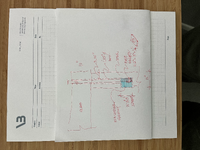bnickeson
Structural
- Apr 7, 2009
- 85
I have a podium-style apartment building where some large cast-in hold down anchor rods were omitted from the top of the foundation wall (despite my huge note on the drawings saying not to forget these). The location that was omitted was, of course, the shear wall with the highest uplift load on the entire building. Approximately 35 kips ultimate, though that was using Exposure C and realistically we're probably B. So you can keep in mind there was some conservatism there.
In any event, the foundation is a 12" thick wall and about 12'-0" tall. The uplift anchor rods are 1 1/8" diameter ideally placed 3 1/4" from the outside face of wall to the center of the bar. I can increase this to around 4" or so if needed. I am trying to post-install a single #9 bar in epoxy with a deep embedment to use development theory to resist this uplift load. I have enough vertical #5 bars in the foundation wall to prevent any tension breakout as these bars are developed where they theoretically cross the breakout cone. Looking at ESR 3814 for Hilti RE-500 V3, Table 31 gives a development length of 32" for a #9 bar and I am thinking of using 36". Section 4.2.3 states for embedment greater than 20db, that required minimum edge clear distance is to be 1 9/16" which isn't much. My biggest concern is just the proximity of the bar to the outside face of the wall and I'm wondering if this "development" of the bar is still adequate or if some other failure mechanism - like side face splitting or bond - would lower the capacity. I talked to Hilti's engineering help desk and they weren't any help.
Does anyone have any further experience with this? Will a 36" embedment in the top of the foundation wall be adequate to develop the strength of the bar? I don't believe we really have any other potential solutions for this location other than cutting a section of the wall down and re-pouring, which isn't an option since the walls are already partially backfilled.
Thanks.
In any event, the foundation is a 12" thick wall and about 12'-0" tall. The uplift anchor rods are 1 1/8" diameter ideally placed 3 1/4" from the outside face of wall to the center of the bar. I can increase this to around 4" or so if needed. I am trying to post-install a single #9 bar in epoxy with a deep embedment to use development theory to resist this uplift load. I have enough vertical #5 bars in the foundation wall to prevent any tension breakout as these bars are developed where they theoretically cross the breakout cone. Looking at ESR 3814 for Hilti RE-500 V3, Table 31 gives a development length of 32" for a #9 bar and I am thinking of using 36". Section 4.2.3 states for embedment greater than 20db, that required minimum edge clear distance is to be 1 9/16" which isn't much. My biggest concern is just the proximity of the bar to the outside face of the wall and I'm wondering if this "development" of the bar is still adequate or if some other failure mechanism - like side face splitting or bond - would lower the capacity. I talked to Hilti's engineering help desk and they weren't any help.
Does anyone have any further experience with this? Will a 36" embedment in the top of the foundation wall be adequate to develop the strength of the bar? I don't believe we really have any other potential solutions for this location other than cutting a section of the wall down and re-pouring, which isn't an option since the walls are already partially backfilled.
Thanks.

